The Winter Hexagon is not only key to finding six of the season’s most prominent constellations but also a gateway to a more than a half-dozen delightful double stars.
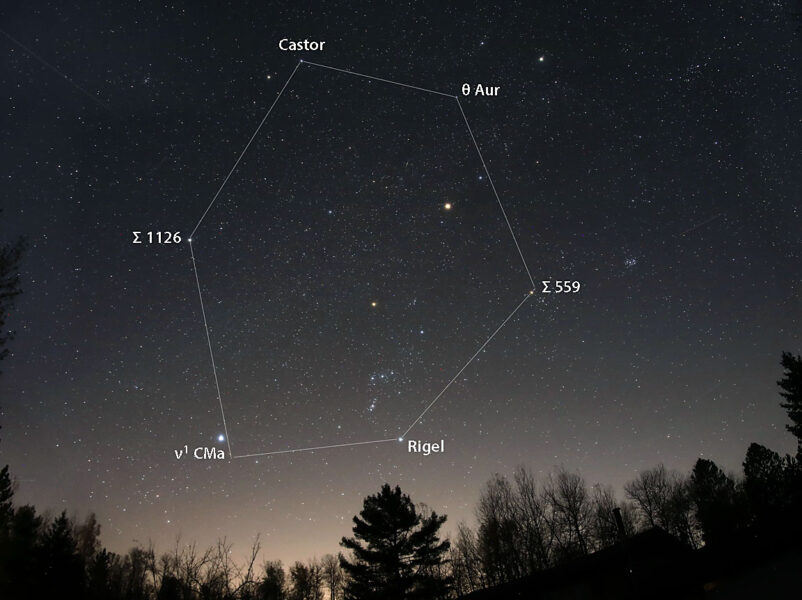
Bob King
No doubt you're already familiar with the season's most prominent asterism, the Winter Hexagon. Each of the figure's six apices glitters with a bright star, starting with Sirius at the southern end and moving up and clockwise to Procyon, Pollux, Capella, Aldebaran, and Rigel. The gargantuan polygon spans 66° from top to bottom and 46° from side to side. All its members shine at first magnitude or brighter and head up a different constellation. Find all six suns, and you've got six easy entry points into each star group (see image below). Only lonely Betelgeuse, locked inside the figure, doesn't participate. To rectify the situation, amateurs have reconfigured the Hexagon into a giant letter "G."
While lack of humidity in cold weather may enhance sky darkness, it's the gathering of these six bright stars and their neighbors that's largely responsible for the impression that winter nights are darkest. Point of fact. If you live where snow cover is the norm, 'tis the most light-polluted season of the year. Light reflected from the white stuff (also six-sided) goes straight up into the sky and scrubs away the fainter stars with wintry vengeance.
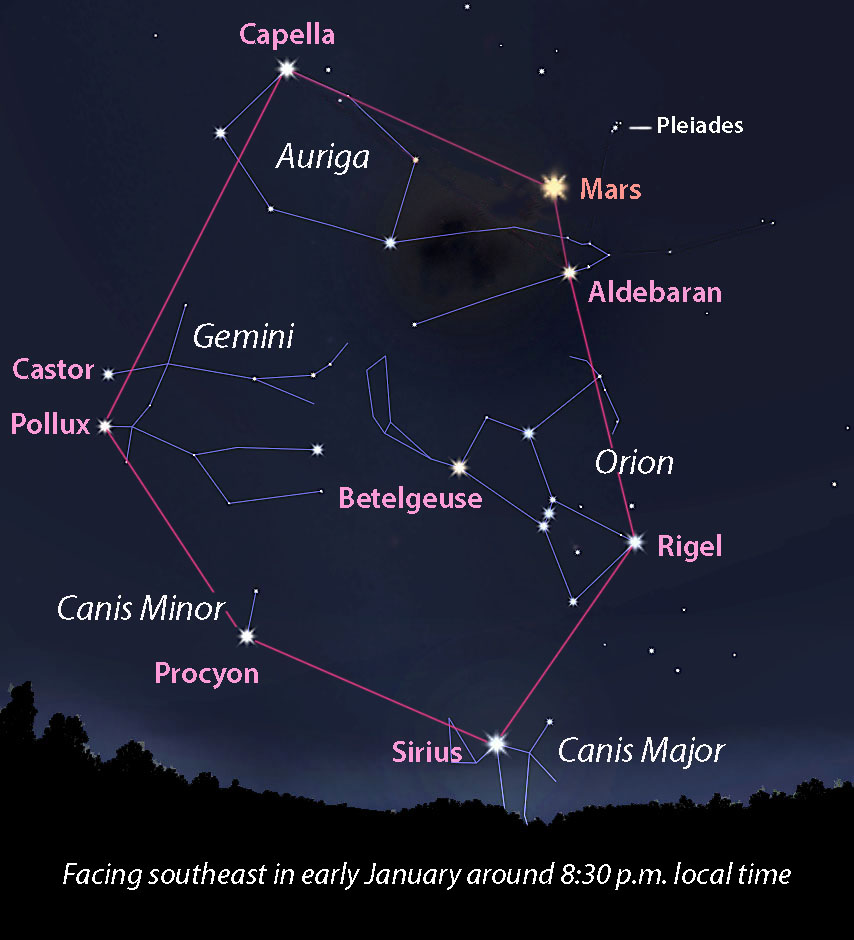
Stellarium with additions by Bob King
Mars has become part of the geometrical equation this season. Moving westward in retrograde motion, it recently busted out of its hexagonal corral and became part of the figure, lengthening its western side. On January 12th, the planet resumes direct motion to the east and will rejoin Betelgeuse inside the asterism again on Valentine's Day.
Three of the Hexagon's members — Sirius, Procyon, and Rigel — are well-known double stars. This made me wonder what other attractive double stars might lie within close proximity of the luminous sextet that could be linked into a similar figure of their own. That and my love of puns is how I arrived at the Winter Pair-a-gon — a six-sided ring of stellar duos that approximately overlaps the beloved asterism.
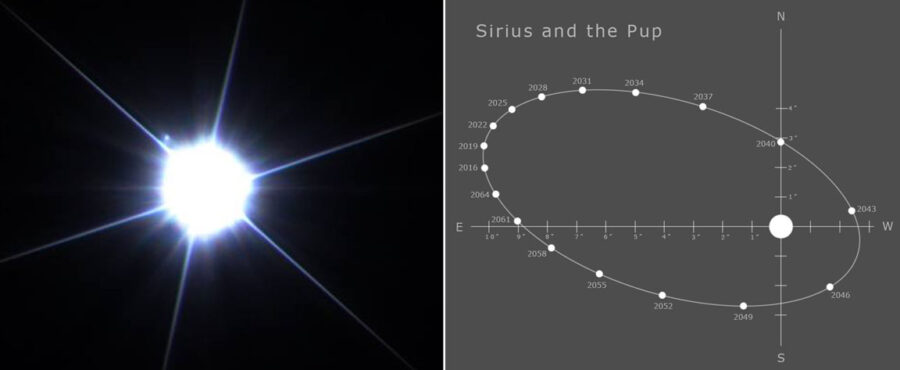
Gabriela and Fabio Carvalho (left); Jerry Lodriguss
Straight off, we'll need to eliminate Procyon from the running. The primary star is nearly 14,000 times brighter than its 10.8-magnitude companion located just 4.8″ distant in PA 328°. I've yet to hear of a single visual observation of Procyon B in the modern era — by all means please prove me wrong! By comparison, separating the Pup from the Dog Star, Sirius, is practically a piece of cake. The two reach their greatest separation of 11.3″ this year, something that won't happen again for another half century. We'll include it in the Pair-a-gon but also offer an easier alternate double in the vicinity.
Success with Sirius requires a night of steady seeing combined with high magnification. If you can clearly see silky diffraction rings encircling the star at 250× or higher, you're good to go. Try placing Sirius out of the field of view or hiding it behind a homemade eyepiece occulting bar to quench the glare. My first look at its white dwarf companion through a friend's telescope several years ago was an astronomical thrill of a lifetime.
| Star | Magnitudes | Separation | P.A. of secondary |
| Sirius A and B | –1.5, 8.4 | 11.3″ | 66° |
| Nu1 (ν1) Canis Majoris | 5.8, 7.4 | 17″ | 265° |
| Σ1126 | 6.6, 7.0 | 0.8″ | 179° |
| Σ1182 | 7.5, 8.8 | 4.9″ | 75° |
| Castor A, B, and C | 1.9, 3.0, 9.8 | AB = 5.4″, AC = 72″ | AB = 52°, AC =164° |
| Theta (θ) Aurigae | 2.6, 7.2 | 4.1″ | 303° |
| Σ559 | 7.0, 7.0 | 3.1″ | 275° |
| Rigel | 0.3, 6.8 | 9.2″ | 202° |
An 8-inch telescope should be all you need to split the famous pair, though some have seen it in apertures as small as 6 inches. If Sirius proves too tough to tackle, slide 2.8° southwest to Nu1 (ν1) Canis Majoris. This easy duo features a 6th-magnitude, pale yellow primary and a comfortably distant 7th-magnitude companion. At low magnification it's an attractive pair that catches the eye in any telescope.
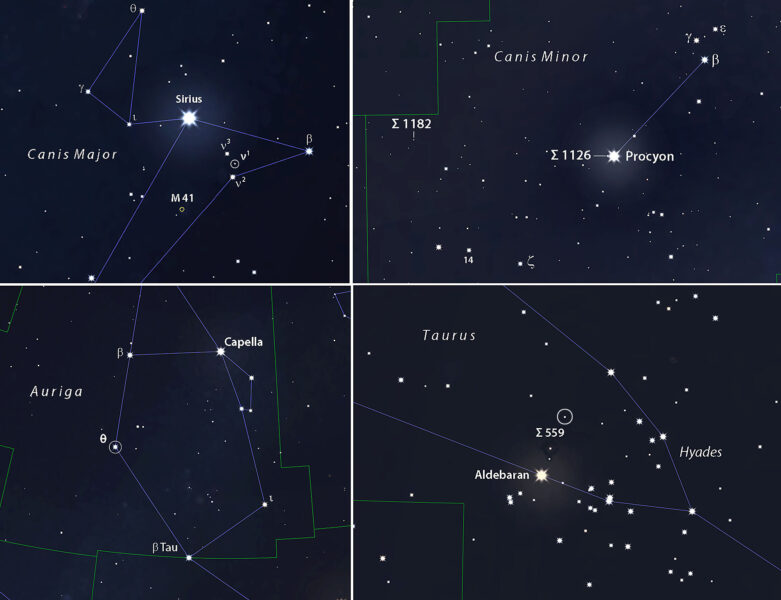
Bob King
Our next pair — Struve (Σ) 1126 — may be hard to split, but at least it's easy to find. Center your scope on Procyon and you'll spot it in the same field just 12.5′ to the east-northeast. I struggled with this one in my 10-inch scope because of multiple nights of poor atmospheric seeing. Then one night, I caught fleeting glimpses of two minute beads nearly touching at 317×. A 6-inch telescope with good optics might barely split these two. If you're unable to crack it, try the consolation double Σ1182 located 6.5° east-northeast of Procyon. While fainter and possessing a greater magnitude spread, the larger separation makes it easy work.
Castor, or Alpha (α) Geminorum, is one of my favorites. Back in the late 1960s, primary and secondary nestled just 1.8″ apart but have since separated to a more comfortable 5.4″. They'll reach a maximum of 6.5″ at the end of this century. Through my 10-inch Dob they're intensely white, bright, and pleasingly close when viewed with a magnification of around 100×. I always show off the radiant couple at public stargazing events in winter and spring.
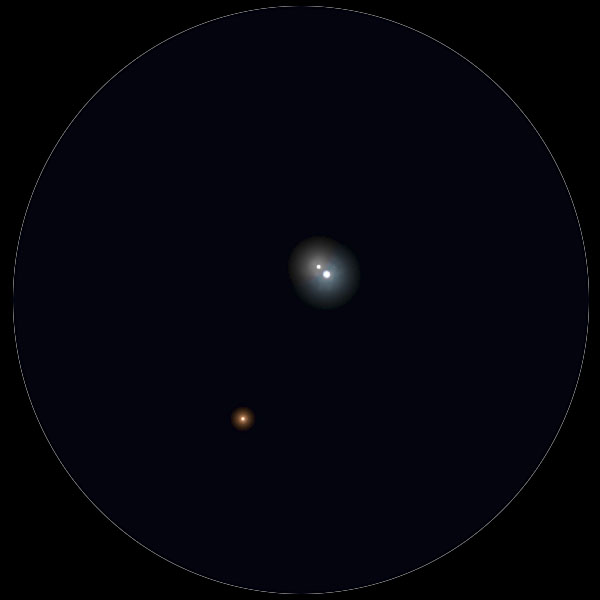
Roberto Mura, CC BY-SA 3.0
Don't forget to look for Castor C, a 10th-magnitude red dwarf situated 72″ southeast of the duo and also part of the system. While Castor A and B orbit one another about every 460 years, the distant dwarf takes upwards of 14,000 years to circle the pair. Each of the three is a spectroscopic binary in turn, making Castor six stars in one. Castor C's red hue is obvious in the 10-inch. Can you see color in a smaller instrument?
Theta (θ) Aurigae, located southeast of Capella, sits at one of the apices of Auriga's pentagonal figure. It's a classic example of an unequal double, where the brightness of the primary and secondary differ by several magnitudes. While these pairs can be challenging, the close proximity of bright and faint stars adds an element of drama to the scene that I find tantalizing. To pull the 7th-magnitude companion from the glare of the main star, use a healthy amount of magnification — I succeeded in exposing the stealthy secondary at 214×.
The double Σ559, located 1.6° north-northwest of Aldebaran, is truly a gem hidden in plain sight. Is there anything more pleasing to the eye than a close-set pair of equally bright stars? With a separation of 3.1″ the twin 7th-magnitude suns are a thing of beauty even in scopes as small as 3 inches. Whenever possible I use the lowest magnification to split binary and multiple stars in order to preserve their sharpness and brilliancy. I like the look of stellar "fire," which increased magnification tends to muddy. With Σ559, a power of 76× kept the pair tight and bright.
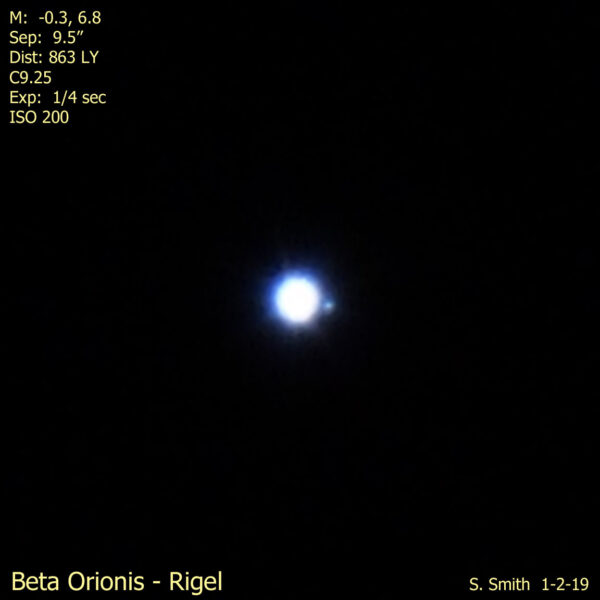
Steve Smith
We come to the final vertex at Rigel in Orion's knee. Talk about an unequal double! Rigel's companion shines a full 6.5 magnitudes fainter than the primary star, but the marked difference in brightness is offset by a significant 9.2″ of separation between the two. I first saw the pair through my 6-inch Edmund reflector as a teenager and still recall how delicate the companion looked alongside the glaring, blue-white primary. I always look in on the duo at least once a winter to relish the extreme contrast between the main star and its companion.
Rigel is a supergiant star about 75 times as large as the Sun and 85,000 times as luminous. Although you'll often read about Betelgeuse going supernova, Rigel's equally likely to do the same. Currently about 10 million years old, it will eventually evolve into a Betelgeuse lookalike before it exits the stage in a brain-blowing explosion. Its companion is actually a spectroscopic binary of Sun-like main sequence stars that appears as a single star. Shining meekly alongside Rigel A it offers a vivid demonstration of the extremes of stellar luminosity. A fourth star of magnitude 15.4 (also a member) glimmers 45″ north of the trio in PA 1°, making Rigel a quadruple.
Happy polygonal travels!
 5
5









Comments
Rod
January 5, 2023 at 9:38 am
Some excellent targets in this report 🙂 Weather for my location has been clouds, light rain, and more clouds 🙂 Perhaps Bob King can provide *oversight* of the weather department and bring some clear skies for me 🙂
You must be logged in to post a comment.
Bob KingPost Author
January 5, 2023 at 6:16 pm
Hi Rod,
Thanks and good observing to you! I wish I had the qualifications for the job. I believe it requires experience as a deity first 🙂
You must be logged in to post a comment.
Chris-Schur
January 6, 2023 at 3:15 pm
I like the "paragon" concept, I think this may encourage more to try some of these doubles. Ive had mixed results with my 10 inch fast astrograph visually on doubles. While Castor and Rigel I can usually split, Sirius has eluded me so many times I think I am cursed! Maybe I should try an aperture stop? Have you found that by using a stop, it can make doubles easier sometimes?
You must be logged in to post a comment.
Bob KingPost Author
January 9, 2023 at 10:07 pm
Hi Chris,
I wonder if a Paracorr might help on your fast scope. Do you have noticeable coma? I have not tried an aperture stop in a long, long time. I usually wait until the seeing is exceptional to attempt Sirius. I also use an occulting bar, a very useful and simple additional to the right eyepiece (mine is an old 12mm Ortho).
You must be logged in to post a comment.
Rod
January 10, 2023 at 7:11 am
I did briefly get some clear skies, I posted two comet observation notes here, https://skyandtelescope.org/astronomy-news/this-weeks-sky-at-a-glance-january-6-14-2/#comment-385825
You must be logged in to post a comment.
You must be logged in to post a comment.